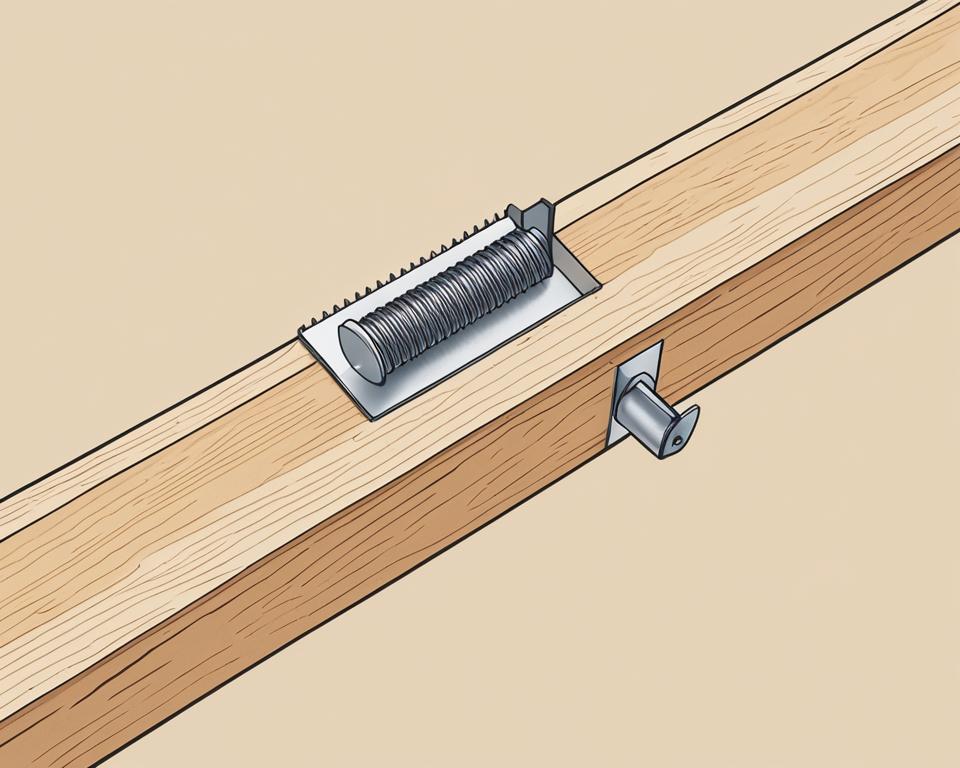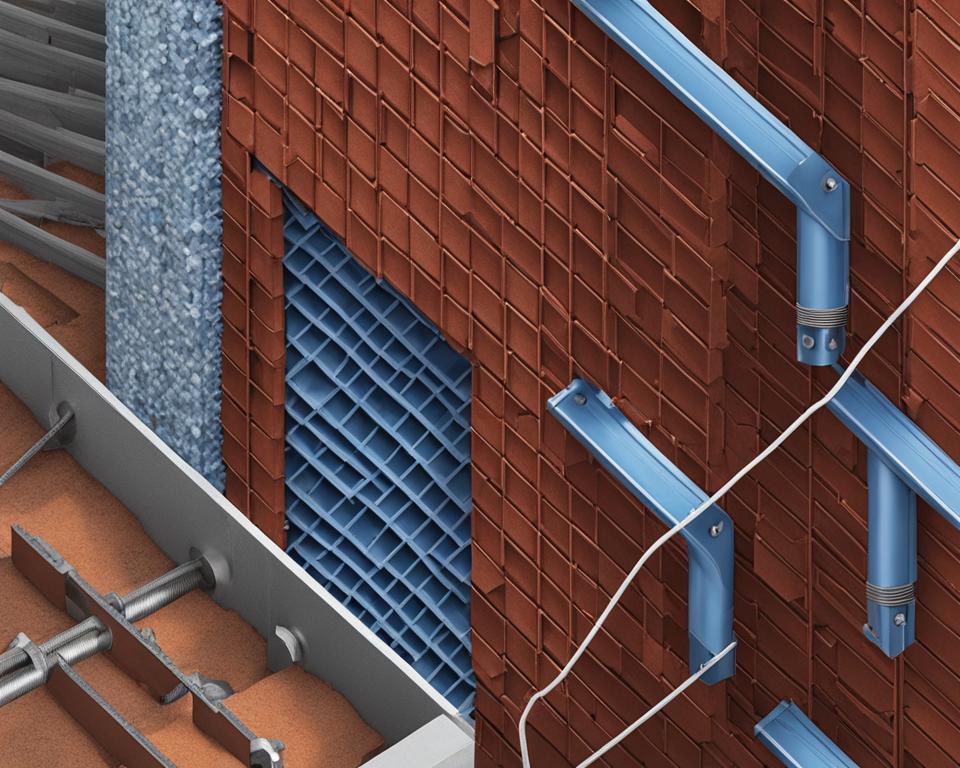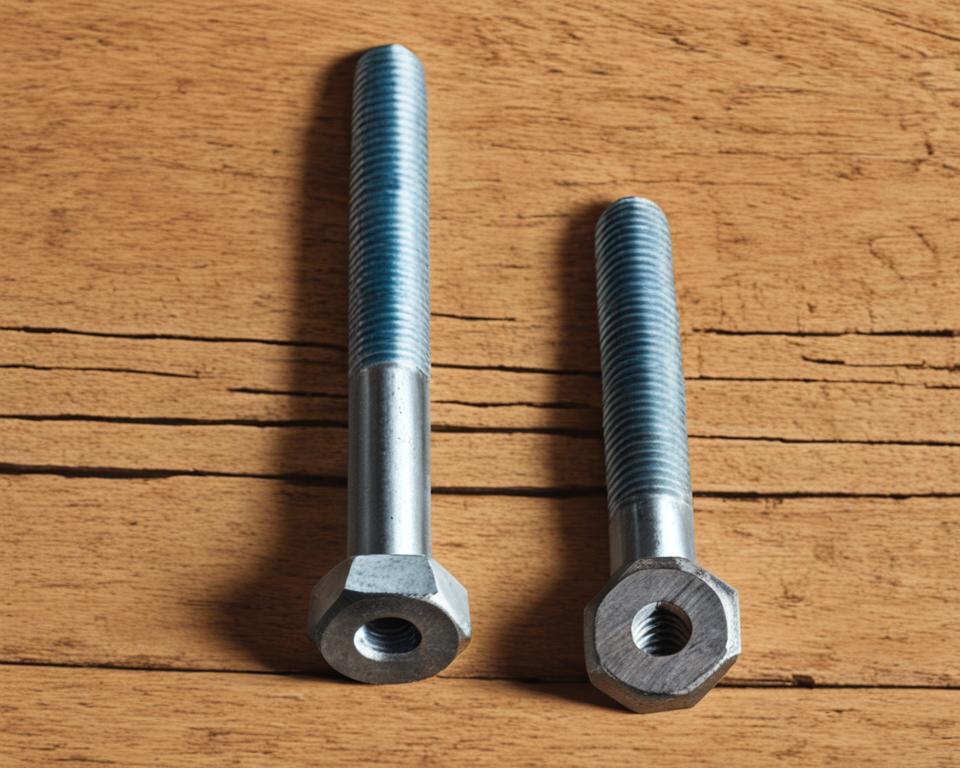When it comes to fastening objects together, through bolts and lag bolts are two popular choices. But what sets them apart? In this article, we’ll compare the strengths of through bolts and lag bolts, and explore the key differences between them. Whether you’re working on a heavy-duty construction project or a smaller DIY endeavor, understanding these bolts’ characteristics can help you make an informed choice for your specific needs.
Key Takeaways:
- Through bolts are designed for heavy-duty applications that require maximum strength and stability.
- Lag bolts are more cost-effective and easier to install, making them suitable for projects where appearance and ease of installation are important factors.
- Through bolts pass completely through two pieces of material, while lag bolts only partially pass through one piece.
- Through bolts offer greater stability and distribute the load evenly, while lag bolts can be hidden once installed correctly.
- Proper maintenance practices, such as regular inspection and lubrication, can extend the lifespan of both types of bolts.
Advantages of Through Bolts
Through bolts offer several advantages over other types of bolts. They are specifically designed to provide maximum strength and stability in heavy-duty applications. When compared to lag bolts, through bolts have the following advantages:
- Strength: Through bolts are stronger and more durable than lag bolts, making them ideal for applications where high strength is required.
- Stability: Through bolts provide greater stability due to their design. They create a secure and reliable connection, especially when attaching ledgers to a house or posts.
- Even Load Distribution: Through bolts distribute the load more evenly between the connected materials, reducing the risk of structural failure and ensuring long-term stability.
- Less Loosening: Compared to lag bolts, through bolts are less likely to loosen over time. This is crucial for applications that experience constant vibrations or heavy loads.
- Reduced Damage: Through bolts cause less damage to the surrounding wood compared to other types of bolts. This is particularly important when working with high-quality or finished wood surfaces.
As a result of these advantages, through bolts should be used when maximum strength and stability are required in a heavy-duty application. They are particularly well-suited for projects such as deck construction, connecting beams or posts together, and building structures like treehouses, sheds, or garages.
“Through bolts provide exceptional strength and stability, making them the go-to choice for heavy-duty applications.”

| Advantages of Through Bolts | When to Use Through Bolts |
|---|---|
| Superior strength and durability | Heavy-duty applications where maximum strength is required |
| Greater stability | Attaching ledgers to a house or posts |
| Even load distribution | Projects that experience constant vibrations or heavy loads |
| Reduced risk of loosening | Long-term applications |
| Less damage to the surrounding wood | High-quality or finished wood surfaces |
Through bolts are a reliable choice when it comes to ensuring the strength and stability of your construction projects.
Advantages of Lag Bolts
Lag bolts offer several advantages that make them a popular choice in various applications. Understanding these advantages can help you determine when to use lag bolts for your projects.
1. Easy Installation
Lag bolts are easier to install compared to through bolts. They only require drilling a single hole, making the installation process quicker and more straightforward. This advantage can save you time and effort when working on smaller projects.
2. Cost-Effectiveness
Lag bolts are also more cost-effective than through bolts. They are available in a wide range of sizes and lengths, allowing you to choose the right bolt for your specific needs without breaking the bank. If you’re working on a budget or have multiple fastening requirements, lag bolts provide an affordable solution.
3. Aesthetics
When appearance is important, lag bolts are an excellent choice. Once installed correctly, the heads of lag bolts remain hidden, providing a clean and seamless look. This advantage makes them suitable for projects where you want to maintain a neat and polished appearance.
Overall, lag bolts are ideal for smaller projects where strength is not the primary concern. Their easy installation, cost-effectiveness, and aesthetic appeal make them a versatile option in various applications.

Applications of Through Bolts
Through bolts are versatile fasteners that find numerous applications in heavy-duty construction projects. Their exceptional strength and stability make them an ideal choice for ensuring secure connections and providing a stable base. Here are some key applications of through bolts:
1. Deck Construction
Through bolts play a vital role in deck construction, where they are used to secure ledger boards to the house, connect beams or joists, and fasten posts to the foundation. These bolts provide a reliable and stable connection, ensuring the safety and durability of the deck structure.
2. Structural Connections
When it comes to connecting beams or posts together, through bolts are the go-to choice. They offer the necessary strength and stability to withstand heavy loads, making them suitable for building structures like bridges, treehouses, sheds, garages, and other load-bearing constructions. Through bolts distribute the weight evenly, preventing stress concentration and enhancing the overall structural integrity.
3. Industrial Applications
The robust nature of through bolts makes them a reliable option for various industrial applications. They are commonly used in the construction of heavy machinery and equipment, ensuring the secure fastening of critical components. Through bolts are also employed in the assembly of framework structures, such as scaffolding or support systems.
Overall, through bolts excel in applications that require maximum strength, stability, and the ability to withstand substantial weight loads. Their exceptional performance and versatility make them a preferred choice for professionals in the construction industry.
| Advantages of Through Bolts |
|---|
| Superior strength and stability |
| Evenly distributes weight and minimizes stress concentration |
| Secures critical connections in heavy-duty constructions |
| Reliable choice for deck construction and structural connections |

Applications of Lag Bolts
Lag bolts have a wide range of applications, making them a versatile choice for various projects. While they may not offer the same level of strength as through bolts, their unique characteristics make them ideal for certain scenarios.
- Smaller DIY Projects: Lag bolts are commonly used in small-scale do-it-yourself projects, such as building wooden climbing walls or furniture. Their ease of installation and secure fastening capabilities make them a popular choice for these types of endeavors.
- Outdoor Construction: In outdoor construction projects, such as deck building, lag bolts play a crucial role in connecting the ledger board to the house or securing posts to the ground. Their ability to provide a strong and durable connection ensures the structural integrity of the construction.
- Projects Where Appearance Matters: Lag bolts are often preferred when the appearance of the finished project is a significant consideration. Since they remain hidden once installed correctly, they provide a clean, seamless look without compromising on functionality.
In the words of renowned carpenter and DIY enthusiast, Bob Villa: “Lag bolts are a reliable choice for projects where both form and function are important. They offer a secure connection while maintaining the aesthetics of the finished product.”
Whether you’re working on a small-scale DIY venture or an outdoor construction project, lag bolts can be an excellent option. Their versatility in applications where strength is not the primary concern, coupled with their ability to deliver a visually appealing result, makes them an indispensable fastener in many scenarios.
Difference Between Through Bolt and Lag Bolt
The main difference between the two types of bolts, through bolts and lag bolts, lies in their construction and application. Understanding this difference is crucial in determining which type of bolt is best suited for your project.
Through bolts are designed to pass completely through two pieces of material, providing a strong and stable connection. They are commonly used in heavy-duty applications where maximum strength is required.
Lag bolts, on the other hand, only partially pass through one piece of material. They are easier to install and more cost-effective compared to through bolts.
Let’s take a closer look at the key differences:
| Through Bolts | Lag Bolts |
|---|---|
| Pass completely through two pieces of material | Partially pass through one piece of material |
| Provide greater strength and stability | Easier to install and more cost-effective |
| Require drilling holes in both pieces being connected | Require only one pre-drilled hole |
Tips for Bolt Maintenance
To ensure the longevity of your bolts, it’s important to follow proper maintenance practices. By taking the time to maintain your bolts, you can prevent damage, ensure optimal performance, and extend their lifespan. Here are some valuable tips for maintaining bolts:
- Continuous Lubrication: Before inserting the bolt, make sure to continuously lubricate the hole. This helps reduce friction, prevent corrosion, and minimize wear and tear.
- Clean the Hole: Before inserting the bolt, it’s crucial to clean the hole to remove any debris or dirt. Use pressurized air to ensure a clean and clear hole, allowing the bolt to fit properly and securely.
- Use the Correct Wrench Size: When tightening bolts, always use the correct wrench or spanner size. Using an incorrectly sized tool can lead to stripped threads, compromising the integrity of the connection. Ensure a proper fit and avoid over-tightening.
- Avoid Force: When inserting or tightening bolts, avoid applying too much force. Forcing the bolts can damage the threads and compromise their functionality. Apply steady pressure and allow the proper torque to secure the connection effectively.
- Regular Inspections: Regularly inspect your bolts for any signs of wear, damage, or loosening. Tighten any loose bolts promptly to maintain the integrity of the connection.
Following these maintenance tips will help ensure the reliability and longevity of your bolts. By taking proactive measures, you can maintain the strength and integrity of your connections, promoting safety and preventing potential issues down the line.
Conclusion
After assessing the strengths and applications of through bolts and lag bolts, it is clear that the choice between the two depends on the specific requirements of your project. If you are working on a heavy-duty application that demands maximum strength and stability, through bolts are the optimal choice. Their ability to pass completely through two pieces of material and evenly distribute the load ensures a secure connection.
On the other hand, if appearance and ease of installation are more important factors, lag bolts are a suitable option. With their partial penetration and hidden installation, lag bolts are often favored in projects where aesthetics matter. Additionally, their cost-effectiveness and availability in various sizes and lengths make them a versatile choice for smaller-scale applications.
To make an informed decision, carefully consider the advantages and applications of each type of bolt. Assess the specific requirements of your project, such as the load-bearing capacity, level of durability, and overall visual appeal. By keeping these factors in mind, you can confidently select the right bolt for your project and ensure a successful outcome.
FAQ
What is the difference between a through bolt and a lag bolt?
Through bolts pass completely through two pieces of material, while lag bolts only partially pass through one piece.
When should I use through bolts?
Through bolts should be used when maximum strength and stability are required, such as in heavy-duty applications like deck construction or connecting beams or posts together.
What are the advantages of through bolts?
Through bolts offer greater strength, stability, and load distribution. They also cause less damage to the surrounding wood compared to lag bolts.
When should I use lag bolts?
Lag bolts are suitable for applications where appearance and ease of installation are important. They are commonly used in outdoor construction and smaller DIY projects.
What are the advantages of lag bolts?
Lag bolts are easier to install, more cost-effective, and available in a variety of sizes and lengths. They remain hidden once installed correctly.
What are the common applications of through bolts?
Through bolts are commonly used in heavy-duty applications such as deck construction, connecting beams or posts together, and building structures like treehouses, sheds, or garages.
What are the common applications of lag bolts?
Lag bolts are frequently used in projects where appearance is important, such as building wooden climbing walls or furniture. They are also commonly used in deck construction for a secure connection between the ledger and house or posts.
What is the difference between a through bolt and a lag bolt?
Through bolts pass completely through two pieces of material, requiring holes in both pieces, while lag bolts only partially pass through one piece, requiring only one pre-drilled hole.
What are some tips for maintaining bolts?
Continuously lubricate the hole before inserting the bolt, clean the hole with pressurized air, use the correct wrench or spanner size when tightening, avoid forcing the bolts, and regularly inspect and tighten if necessary.
